I'm running in rigging that basically runs parallel(ish) to the masts. I can usually find a line where the ropes don't bite too hard against each other but some are just next to impossible to get from point "A" to "B" without touch/leaning against another rope. Is it inevitable that some rope will touch. Maybe even pull each other slightly out of line
-
LUCZORAMA SHIPWRECK SCAVENGER HUNT GIVEAWAY. 4 Weeks of Fun • 1 Legendary Prize ((OcCre’s Fram Ship)) • Global Crew Welcome!
**VIEW THREAD HERE**
You are using an out of date browser. It may not display this or other websites correctly.
You should upgrade or use an alternative browser.
You should upgrade or use an alternative browser.
Thanks for answering Alan.  Pictures may be tough, there's just too much going on but I'll try after I've finished my coffee. The ones that are bothering me now are the main topgallant lifts. The fall goes from the block at the top to belay on a cleat on the inside of the third topmast shroud. This means it has to go from outside and above the shrouds to inside the shrouds so it rubs on the aft shroud.
Pictures may be tough, there's just too much going on but I'll try after I've finished my coffee. The ones that are bothering me now are the main topgallant lifts. The fall goes from the block at the top to belay on a cleat on the inside of the third topmast shroud. This means it has to go from outside and above the shrouds to inside the shrouds so it rubs on the aft shroud.
This is just one of the first ropes that run down the mast. I'm sure there will be more. Since a lot of the belaying points were at the Captains discretion would it be OK to just change the belaying point so that it doesn't chafe. I'm getting my belaying points from Lees and Petersson and neither of them are an exact match to the Discovery1789.
PS_ I can't get any pictures. The camera/phone focuses on the wrong thing and what I want to show is blurry.
This is just one of the first ropes that run down the mast. I'm sure there will be more. Since a lot of the belaying points were at the Captains discretion would it be OK to just change the belaying point so that it doesn't chafe. I'm getting my belaying points from Lees and Petersson and neither of them are an exact match to the Discovery1789.
PS_ I can't get any pictures. The camera/phone focuses on the wrong thing and what I want to show is blurry.
Last edited:
Hi Don.
From Steel.
TOPGALLANT-LIFTS are single, and go over the yard-arm with an eye spliced in one end; the other end reeves through a thimble in the topgallant-shrouds, leads down into the top, and belays round the dead-eyes.
From Lever.
The lifts are reeved through a thimble seized in between the two foremost top-gallant shrouds, just below, the eye seizing.
From Lees.
Third rates and below, lifts were rigged singly and sometimes thimbles were used in stead of pendent blocks.
This would avoid the rubbing issue.
Interestingly Steel and Lever do not
Regards
Allan
From Steel.
TOPGALLANT-LIFTS are single, and go over the yard-arm with an eye spliced in one end; the other end reeves through a thimble in the topgallant-shrouds, leads down into the top, and belays round the dead-eyes.
From Lever.
The lifts are reeved through a thimble seized in between the two foremost top-gallant shrouds, just below, the eye seizing.
From Lees.
Third rates and below, lifts were rigged singly and sometimes thimbles were used in stead of pendent blocks.
This would avoid the rubbing issue.
Interestingly Steel and Lever do not
Regards
Allan
I'm not sure I'm following you Oz Allan.(too many Alans  ) It's from the pendant blocks down to the cleat on the shroud that I'm having the problem. If I drop the lift directly down from the pendant blocks to the top I clear everything but now I'm on the outside of the shrouds and the cleat is on the inside. Do I just thread it through the ratlines? The cleat is supposed to be on the inside of the shroud isn't it?
) It's from the pendant blocks down to the cleat on the shroud that I'm having the problem. If I drop the lift directly down from the pendant blocks to the top I clear everything but now I'm on the outside of the shrouds and the cleat is on the inside. Do I just thread it through the ratlines? The cleat is supposed to be on the inside of the shroud isn't it?
Hi Don.
There are no pendant blocks.
The single lifts just go through the thimble seized between the first two shrouds.
Lees often ignores smaller vessels although in this case (or should I say instance ha ha) he does say in 3rd rates and below.
The yard would be lowered and raised with the halliard, The lifts tensioned and taking the load when in position.
So, on small yards the thimble is quite sufficient.
This is not shown on my drawings as I have added it after your post.
Regards Allan
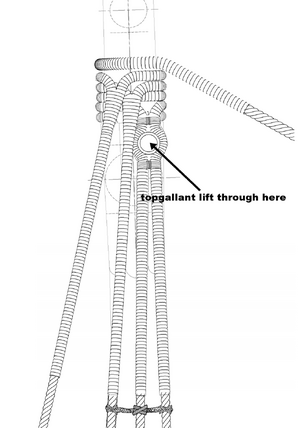
There are no pendant blocks.
The single lifts just go through the thimble seized between the first two shrouds.
Lees often ignores smaller vessels although in this case (or should I say instance ha ha) he does say in 3rd rates and below.
The yard would be lowered and raised with the halliard, The lifts tensioned and taking the load when in position.
So, on small yards the thimble is quite sufficient.
This is not shown on my drawings as I have added it after your post.
Regards Allan

So basically the same as the topmast but single and with thimbles instead of sister blocks. I just went out and looked and I think that will make my problem worse. The thimble will get the lift inside the topgallant shrouds and I can get through between the topmast crosstrees but now I have to find a way through/around the topmast shrouds. I think I'll use a piece of straight wire to try and find a path. This will take some puzzling. First i have to make some small thimbles. I'm assuming the fore and main masts are the same. Thanks for the help.
Here's the best I can do. You can see that the lift(blue arrow) leans against the cross tree and then bends around and behind the shroud. I made the thimble by waxing a piece of wire, tying a half hitch around it with heavy thread and soaking it with CA. I pushed it off the wire. Then I laid it across the two shrouds and put a tiny drop of CA on each tag end to hold it. Hopefully it will last.
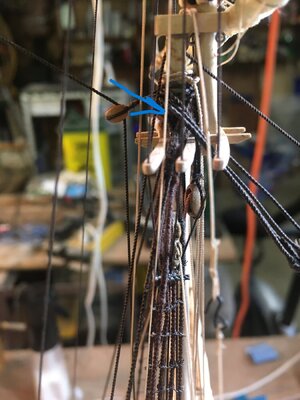
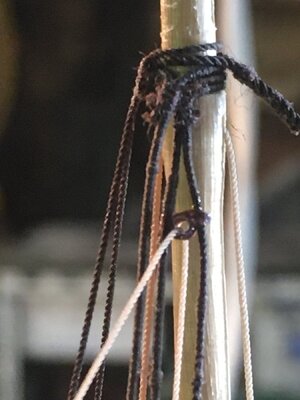


OK While I was working on the top gallant yard lifts I noticed that the top sail lifts were rubbing on the side of the lubber hole so I looked in Steel. He says
"The standing-part hooks to a becket round the topmast-cap, and the leading-part leads down the side of the mast, and belays to the dead-eyes in the lower shrouds."
If they belay to the lower shrouds they must go through the lubber hole and then splay out. How do they deal with the lifts rubbing on the side of the lubber hole? Is it like you said for the thimbles on the top gallant lift, there's not that much wear on a lift
Sorry to be such a PITA.
"The standing-part hooks to a becket round the topmast-cap, and the leading-part leads down the side of the mast, and belays to the dead-eyes in the lower shrouds."
If they belay to the lower shrouds they must go through the lubber hole and then splay out. How do they deal with the lifts rubbing on the side of the lubber hole? Is it like you said for the thimbles on the top gallant lift, there's not that much wear on a lift
Sorry to be such a PITA.
Interesting Don. I read Lees' and he says they "went down to the deck via holes in the top." Well that does not clarify that at all, what holes?
If he meant the lubbers holes he would have said "the holes"
Anyhow now I would like to know when cutting holes in the top for rigging started.
It is common place in later vessels but when did it first start.
Maybe some one else has some documentation on it.
Allan
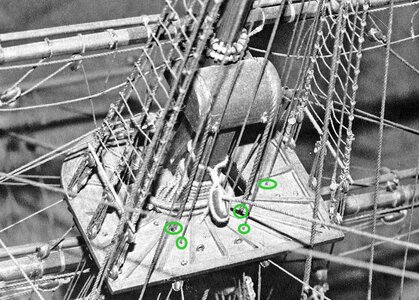
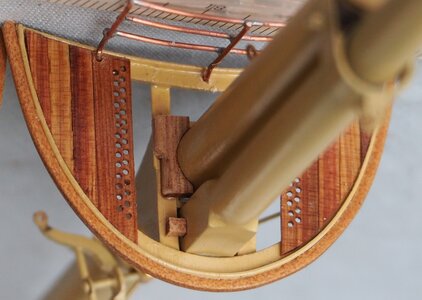
If he meant the lubbers holes he would have said "the holes"
Anyhow now I would like to know when cutting holes in the top for rigging started.
It is common place in later vessels but when did it first start.
Maybe some one else has some documentation on it.
Allan


That black and white picture is interesting. I first ran into this when I was doing the main course lifts. It just didn't seem right to have the lift rub on the lubbers hole. I looked and looked for any info and struck out. Then one day I was looking at Dan Vadas' "Vulture" for something completely different and spotted two little slots in the top right about where I wanted the lift to be. He never mentioned them in the write up and I've never seen them anywhere else. Maybe I should be thinking a little harder about this. I do know it was a pain in the butt to figure out where the hole should go. It will be even tougher with much more rigging done 
A model is a model. My meaning is unless you are a stickler for historical accuracy, I learned that in modeling try to run rigging from start point to belay unobstructed. That might mean threading through other rigging, through holes in structures aloft, and in the case of one of my models through holes in the railings and bulwarks. Basically run rigging to the belay point as straight and clean as you can, then shift the belay point to accommodate the run…no rubbing and no interference with structures or standing or running rigging.
A model is a model. My meaning is unless you are a stickler for historical accuracy, I learned that in modeling try to run rigging from start point to belay unobstructed. That might mean threading through other rigging, through holes in structures aloft, and in the case of one of my models through holes in the railings and bulwarks. Basically run rigging to the belay point as straight and clean as you can, then shift the belay point to accommodate the run…no rubbing and no interference with structures or standing or running riggin
I think there is a problem of scale, the "ropes" and "blocks" we tend to use are generally over scale and so the running of the ropes do not necessarily go in the correct direction
What was a 2" gap on the real ship between 2 ropes is down to zero and so ropes will seem to rub but expand the gap by 48 or 96 scale it will disappear
Just my thoughts.. maybe junk lol
What was a 2" gap on the real ship between 2 ropes is down to zero and so ropes will seem to rub but expand the gap by 48 or 96 scale it will disappear
Just my thoughts.. maybe junk lol



